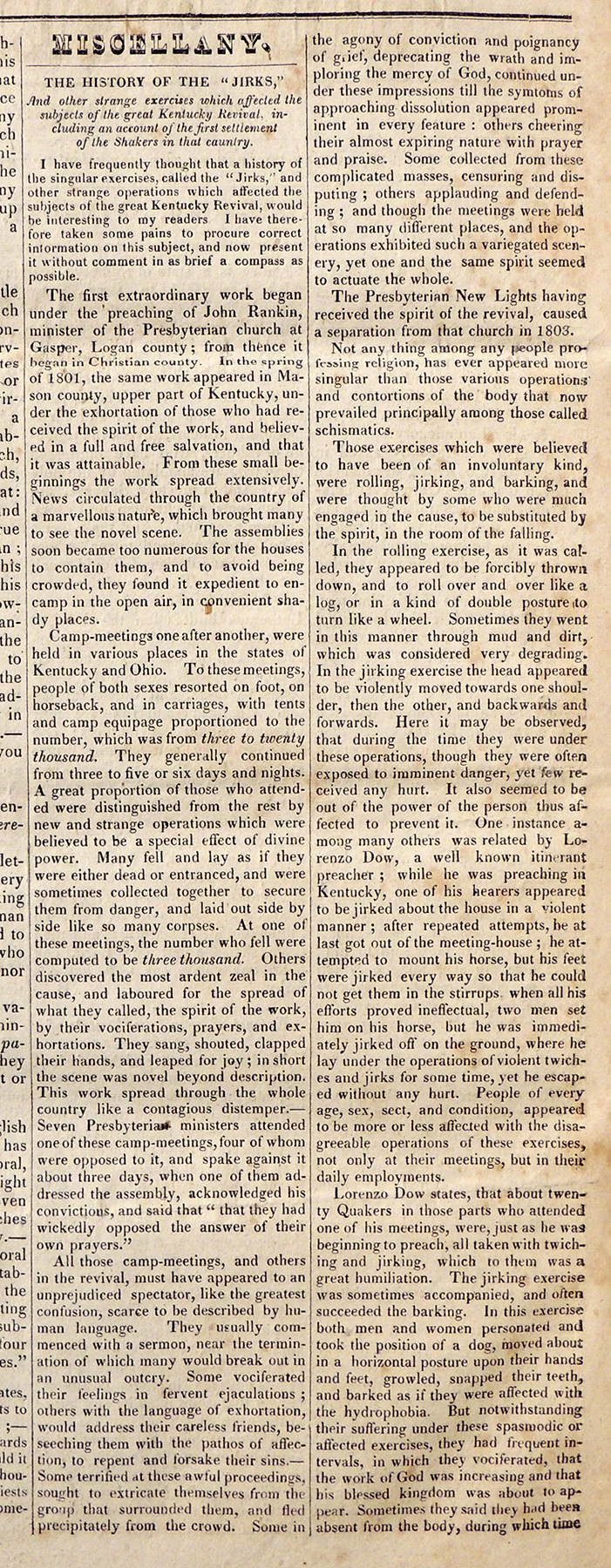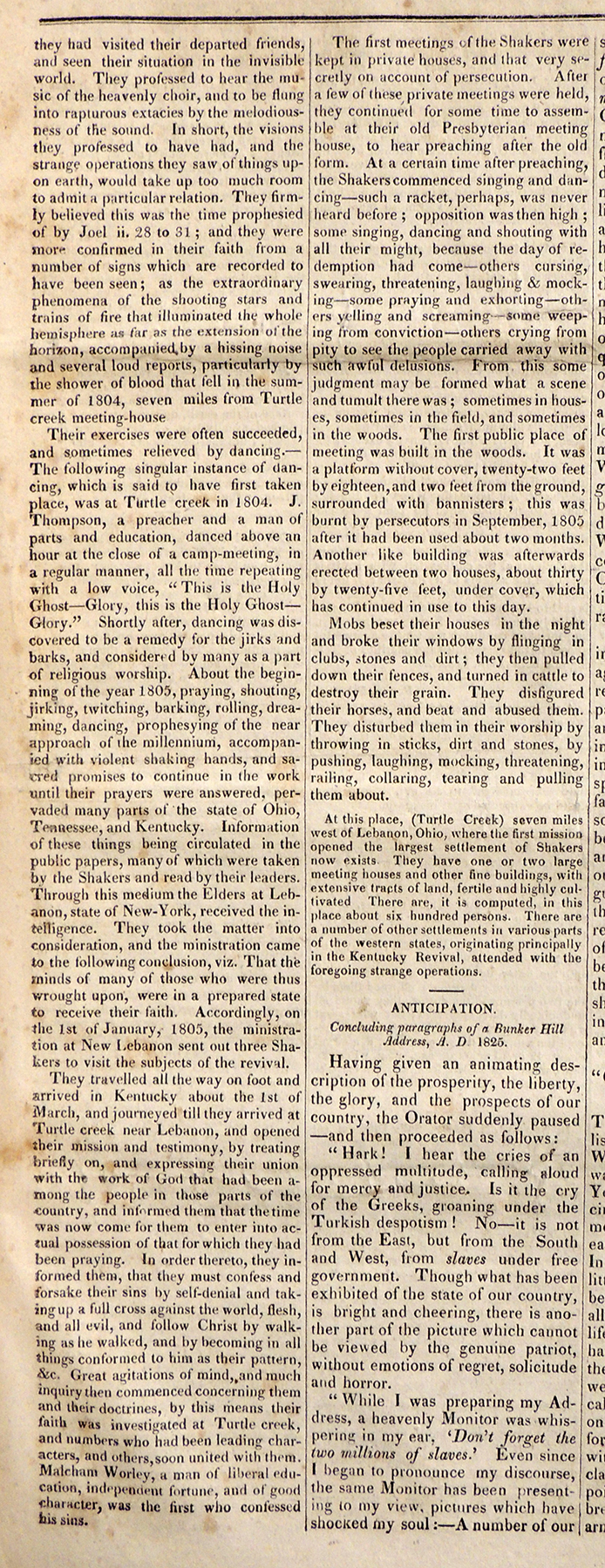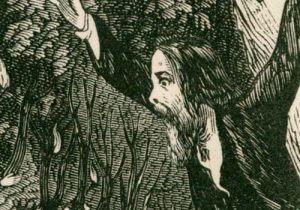Published in a prominent New York newspaper, this short “History of the ‘Jirks’” provides an excellent index of the state of public discourse on the bodily exercises a generation after the Great Revival. Derived largely from Richard McNemar’s Kentucky Revival (click here) and Lorenzo Dow’s History of Cosmopolite (click here), the article locates the jerks with a broader arc of camp meetings, church schisms, and the rise of western Shakerism.
THE HISTORY OF THE “JIRKS,”
And other strange exercises which affected the subjects of the great Kentucky Revival, including an account of the first settlement of the Shakers in that country.
I have frequently thought that a history of the singular exercises, called the “Jirks,” and other strange operations which affected the subjects of the great Kentucky Revival, would be interesting to my readers. I have therefore taken some pains to procure correct information on this subject, and now present it without comment in as brief a compass as possible.
The first extraordinary work began under the preaching John Rankin, minister of the Presbyterian church at Gasper, Logan county; from thence it began in Christian county. In the spring of 1801, the same work appeared in Mason county, upper part of Kentucky, under the exhortation of those who had received the spirit of the work, and believed in a full and free salvation, and that it was attainable. From these small beginnings the work spread extensively. News circulated through the country of a marvellous nature, which brought many to see the novel scene. The assemblies soon became too numerous for the houses to contain them, and to avoid being crowded, they found it expedient to encamp in the open air, in convenient shady places.
Camp-meetings one after another, were held in various places in the states of Kentucky and Ohio. To these meetings, people of both sexes resorted on foot, on horseback, and in carriages, with tents and camp equipage proportioned to the number, which was from three to twenty thousand. They generally continued from three to five or six days and nights. A great proportion of those who attended were distinguished from the rest by new and strange operations which were believed to be a special effect of divine power. Many fell and lay as if they were either dead or entranced, and were sometimes collected together to secure them from danger, and laid out side by side like so many corpses. At one of these meetings, the number who fell were computed to be three thousand. Others discovered the most ardent zeal in the cause, and laboured for the spread of what they called, the spirit of the work, by their vociferations, prayers, and exhortations. They sang, shouted, clapped their hands, and leaped for joy; in short the scene was novel beyond description. This work spread through the whole country like a contagious distemper.—Seven Presbyterian ministers attended one of these camp-meetings, four of whom were opposed to it, and spake against it about three days, when one of them addressed the assembly, acknowledged his convictions, and said that “that they had wickedly opposed the answer of their own prayers.”
All those camp-meetings, and others in the revival, must have appeared to an unprejudiced spectator, like the greatest confusion, scarce to be described by human language. They usually commenced with a sermon, near the termination of which many would break out in an unusual outcry. Some vociferated their feelings in fervent ejaculations; others with the language of exhortation, would address their careless friends, beseeching them with the pathos of affection, to repent and forsake their sins.—Some terrified at these awful proceedings, sought to extricate themselves from the group that surrounded them, and fled precipitately from the crowd. Some in the agony of conviction and poignancy of grief, deprecating the wrath and imploring the mercy of God, continued under these impressions till the symptoms of approaching dissolution appeared prominent in every feature: others cheering their almost expiring nature with prayer and praise. Some collected from these complicated masses, censuring and disputing; others applauding and defending; and though the meetings were held at so many different places, and the operations exhibited such a variegated scenery, yet one and the same spirit seemed to actuate the whole.
The Presbyterian New Lights having received the spirit of the revival, caused a separation from that church in 1803.
Not any thing among any people professing religion, has ever appeared more singular than those various operations and contortions of the body that now prevailed principally among those called schismatics.
Those exercises which were believed to have been of the involuntary kind, were rolling, jirking, and barking, and were thought by some who were much engaged in the cause, to be substituted by the spirit, in the room of falling.
In the rolling exercise, as it was called, they appeared to be forcibly thrown down, and to roll over and over like a log, or in a kind of double posture to turn like a wheel. Sometimes they went in this manner through mud and dirt, which was considered very degrading. In the jirking exercise the head appeared to be violently moved towards one shoulder, then the other, and backwards and forwards. Here it may be observed, that during the time they were under these operations, though they were often exposed to imminent danger, yet few received any hurt. It also seemed to be out of the power of the person thus affected to prevent it. One instance among many others was related by Lorenzo Dow, a well known itinerant preacher; while he was preaching in Kentucky, one of his hearers appeared to be jirked about the house in a violent manner; after repeated attempts, he at last got out of the meeting-house; he attempted to mount his horse, but his feet were jirked every way so that he could not get them in the stirrup. When all his efforts proved ineffectual, two men set him on his horse, but he was immediately jirked off on the ground, where he lay under the operations of violent twitching and jirks for some time, yet he escaped without any hurt. People of every age, sex, sect, and condition, appeared to be more or less affected with the disagreeable operations of these exercises, not only at their meetings, but in their daily employments.
Lorenzo Dow states, that about twenty Quakers in those parts who attended one of his meetings, were, just as he was beginning to preach, all taken with twitching and jirking, which to them was a great humiliation. The jirking exercise was sometimes accompanied, and often succeeded the barking. In this exercise both men and women personated and took the position of a dog, moved about in a horizontal posture upon their hands and feet, growled, snapped their teeth, and barked as if they were affected with the hydrophobia. But notwithstanding their suffering under these spasmodic or affected exercises, they had frequent intervals, in which they vociferated, that the work of God was increasing and that his blessed Kingdom was about to appear. Sometimes they said they had been absent from the body, during which time they had visited their departed friends, and seen their situation in the invisible world. They professed to hear the music of the heavenly choir, and to be flung into rapturous extacies by the melodiousness of the sound. In short, the visions they professed to have had, and the strange operations they saw of things upon earth, would take up too much room to admit a particular relation. They firmly believed this was the time prophesied of by Joel ii. 28 to 31; and they were more confirmed in their faith from a number of signs which are recorded to have been seen; as the extraordinary phenomena of the shooting stars and trains of fire that illuminated the whole hemisphere as far as the extension of the horizon, accompanied by a hissing noise and several loud reports, particularly by the shower of blood that fell in the summer of 1804, seven miles from Turtle creek meeting-house.
Their exercises were often succeeded, and sometimes relieved by dancing.—The following singular instance of dancing, which is said to have first taken place, was at Turtle creek in 1804. J. Thompson, a preacher and a man of parts and education, danced about an hour at the close of a camp-meeting, in a regular manner, all the time repeating with a low voice, “This is the Holy Ghost—Glory, this is the Holy Ghost—Glory.” Shortly after, dancing was discovered to be a remedy for the jirks and barks, and considered by many as a part of religious worship. About the beginning of the year 1805, praying, shouting, jirking, twitching, barking, rolling, dreaming, dancing, prophesying of the near approach of the millennium, accompanied with violent shaking hands, and sacred promises to continue in the work until their prayers were answered, pervaded many parts of the state of Ohio, Tennessee, and Kentucky. Information of these things being circulated in the public papers, many of which were taken by the Shakers and read by their leaders. Through this medium the Elders at Lebanon, state of New-York, received the intelligence. They took the matter into consideration, and the ministration came to the following conclusion, viz. That the minds of many of those who were thus wrought upon, were in a prepared state to receive their faith. Accordingly, on the 1st of January, 1805, the ministration at New Lebanon sent out three Shakers to visit the subjects of the revival.
They travelled all the way on foot and arrived in Kentucky about the 1st of March, and journeyed till they arrived at Turtle creek near Lebanon, and opened their mission and testimony, by treating briefly on, and expressing their union with the work of God that had been among the people in those parts of the country, and informed them that the time was now come for them to enter into actual possession of that for which they had been praying. In order thereto, they informed them, that they must confess and forsake their sins by self-denial and taking up a full cross against the world, flesh, and all evil, and follow Christ by walking as he walked, and by becoming in all things conformed to him as their pattern, &c. Great agitations of mind, and much inquiry then commenced concerned them and their doctrines, by this means their faith was investigated at Turtle creek, and numbers who had been leading characters, and others, soon united with them. Malcham Worley, a man of liberal education, independent fortune, and of a good character, was the first who confessed his sins.
The first meetings of the Shakers were kept in private houses, and that very secretly on account of persecution. After a few of these private meetings were held, they continued for some time to assemble at their old Presbyterian meeting house, to hear preaching after the old form. At a certain time after preaching, the Shakers commenced singing and dancing—such a racket, perhaps, was never heard before; opposition was then high; some singing, dancing and shouting with all their might, because the day of redemption had come—others cursing, swearing, threatening, laughing & mocking—some praying and exhorting—others yelling and screaming—some weeping from conviction—others crying from pity to see the people carried away with such awful delusions. From this some judgment may be formed what a scene and tumult there was; sometimes in houses, sometimes in the field, and sometimes in the woods. The first public place of meeting was built in the woods. It was a platform without cover, twenty-two feet by eighteen, and two feet from the ground, surrounded with bannisters; this was burnt by persecutors in September, 1805 after it has been used about two months. Another like building was afterwards erected between two houses, about thirty by twenty-five feet, under cover, which has continued in use to this day.
Mobs beset their houses in the night and broke their windows by flinging in clubs, stones and dirt; they then pulled down their fences, and turned in cattle to destroy their grain. They disfigured their horses, and beat and abused them. They disturbed them in their worship by throwing in sticks, dirt and stones, by pushing, laughing, mocking, threatening, railing, collaring, tearing and pulling them about.
Source
“The History of the ‘Jirks,” [New York] Telescope 2:38 (February 18, 1826): 150–151.
Images courtesy of the American Antiquarian Society, Worcester, Massachusetts.


